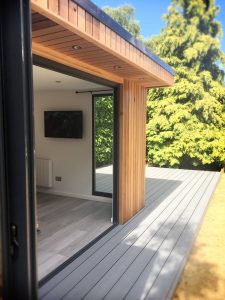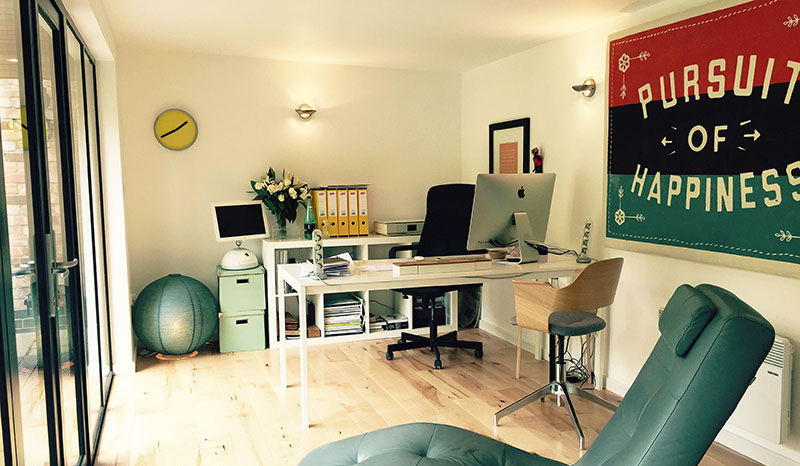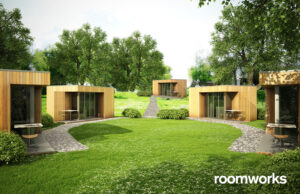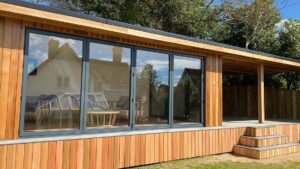Having a garden room can be fantastic in the summer months, but as the days get shorter and colder, you will want to ensure your garden room is well heated. In fact, one of the most common questions we are asked regarding our garden rooms is whether they will be warm in winter, and how easy they are to heat.
The good news is that it is fairly straightforward to heat a garden room, in fact, there are several options. Key points to consider when heating your garden room are the power sources available, your intended use of the room and how much you want to spend.

Here are 8 options for heating your garden room:
1. Electric radiators
Electric radiators look the same as radiators you would normally have in your home, except that they have an electric element to heat them. They can be a little slower to warm up than convection heaters, and there’s a little less control when it comes to the temperature. You can, however, link them to a thermostat and/or a timer to ensure your garden room is the optimum temperature when you want to use it. Electric radiators are a good option if you are planning to use your garden room as something like a workshop where it’s likely to get dusty. Because they have no exposed heating element they pose less of a fire risk.
2. Electric convection heaters
Electric convection heaters are a very popular choice for people wishing to use their garden room all year round. They can be either free-standing or wall-mounted, and will heat your space fairly quickly. Many come with a timer and a thermostat, allowing you to control the temperature and ensure your garden room is nicely warm when you come to use it in the morning. Electric convection heaters are relatively inexpensive and easy to fit; they can be plugged into an existing energy supply.
3. Electric oil filled radiators
Electric oil-filled radiators are usually freestanding, which is useful if you want to pack them away during the summer months, but it does also mean they will take up valuable floor space when in use. The oil in an oil-filled radiator heats up and retains the heat, meaning they continue to heat your space after they have been switched off. These are inexpensive and widely available, but there is not usually a great deal of choice when it comes to style.
4. Underfloor heating
Underfloor heating can be great for those who don’t wish to have visible radiators on walls etc, and it feels wonderful to walk on a heated floor – but generally speaking, underfloor heating will not give off enough heat on its own to maintain a good temperature in your garden room. Instead, underfloor heating is best considered as a secondary heating source. The best sort of underfloor heating for a garden office or room uses a mesh heating element which is cut to size and fitted directly below the floor. Although this is great for the aesthetic of your garden room, it does have the drawback of limiting the types of flooring you can use with it. As well as this, if there are any maintenance issues with your underfloor heating, the floor will need to be taken up which makes it more expensive to maintain than other options.
5. Wood burning stoves
A wood-burning stove is very rare in that it is both traditional and stylish. A wood burner looks fantastic in a garden room, whether it’s a modern design or a more rustic, traditional timber cabin. Wood burners heat up quickly and retain heat well. Because of the smoke given off by burning, a wood burner must be professionally installed – and installation costs, as well as the cost of a flue, are things to take into consideration as both of these can bump up the initial price of a wood burner.
6. Bottled gas heating
This is a great option for a garden room that does not have a mains electricity supply. If you already use bottled gas, it is very practical to use gas heaters in your garden room – just order an extra bottle or two in your regular deliveries. You can either use a gas bottle to fuel a standalone heater in your garden room, or there is the option to have a bottle fitted outside of your property to feed wall mounted heaters inside. It’s very important when considering this option to note that gas heating requires adequate ventilation to prevent the buildup of water vapour or toxic fumes.
7. Solar heating
If you’re looking for low running costs and high environmental friendliness, solar heating is a great choice. When using solar heating for a garden room, you will usually have a series of tubes mounted on the roof which are used to warm water which then feeds a radiator inside. Initial set-up costs can be fairly high, although there are a few DIY options available if you want to try your hand at being even more green and recycling drinks cans and old radiators. The main drawback with solar heating is that it will work best when the sun is warmest – and therefore when you are least likely to need it.
8. Insulation and passive heating
When it comes to reducing ongoing heating costs, insulation and passive heating are the best way to go. Your garden room can be designed with features like south-facing windows and dark floor tiling to retain heat from the sun. Good quality double glazing and ensuring you have draught-proofing for doors and windows will help to retain the heat. With great insulation in both the floor and roof as well as the walls, you can limit how much additional heating you need through the colder months.
When it comes to the heating options for your garden office or room, there is no one size fits all approach. Instead, it comes down to your personal preference and budget, the fuel sources available to you and of course your intended use for the garden room.
Get in touch today to discuss your garden room requirements.





Pingback: Benefits of Garden Rooms for Your Outdoor Space - Ark Garden rooms